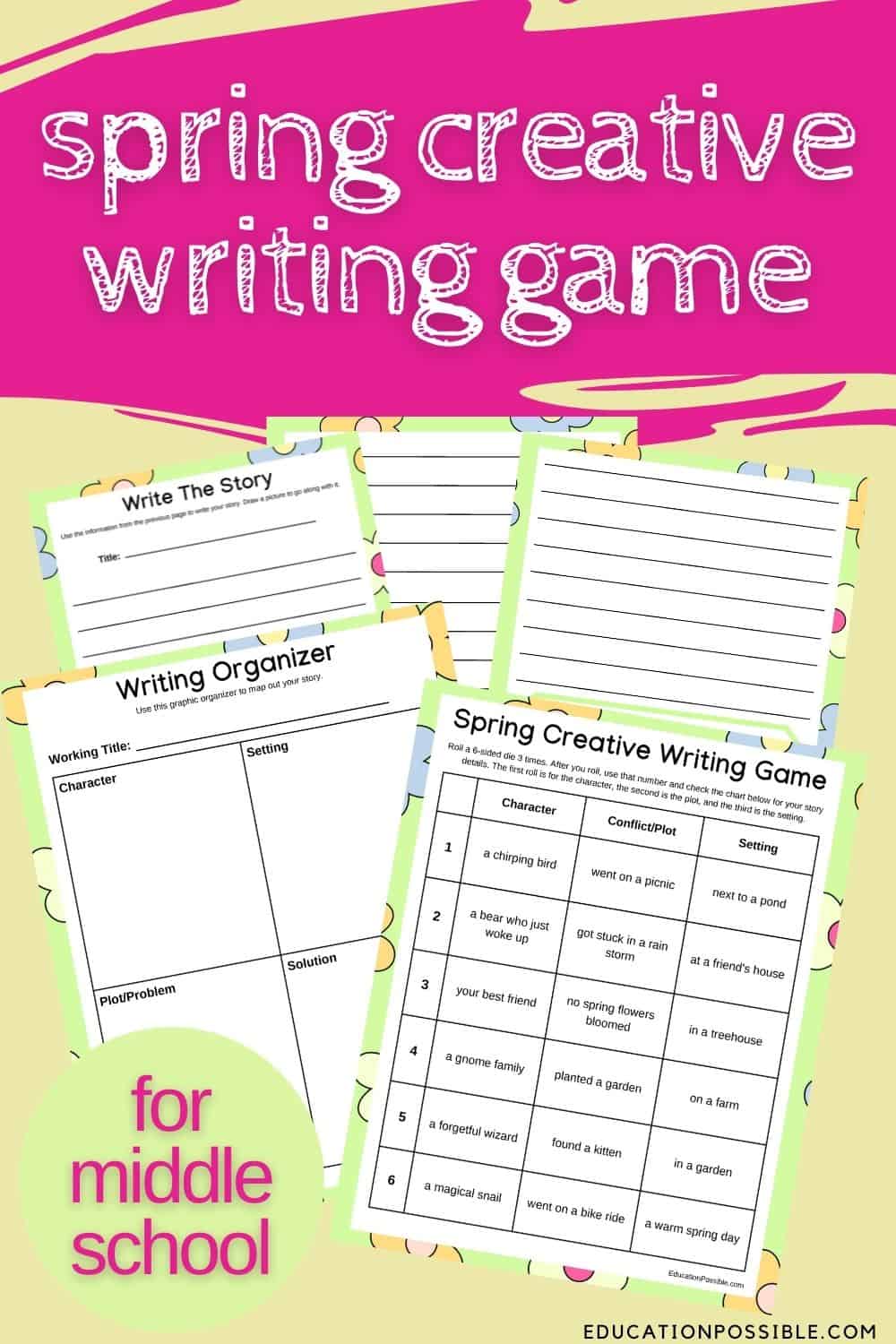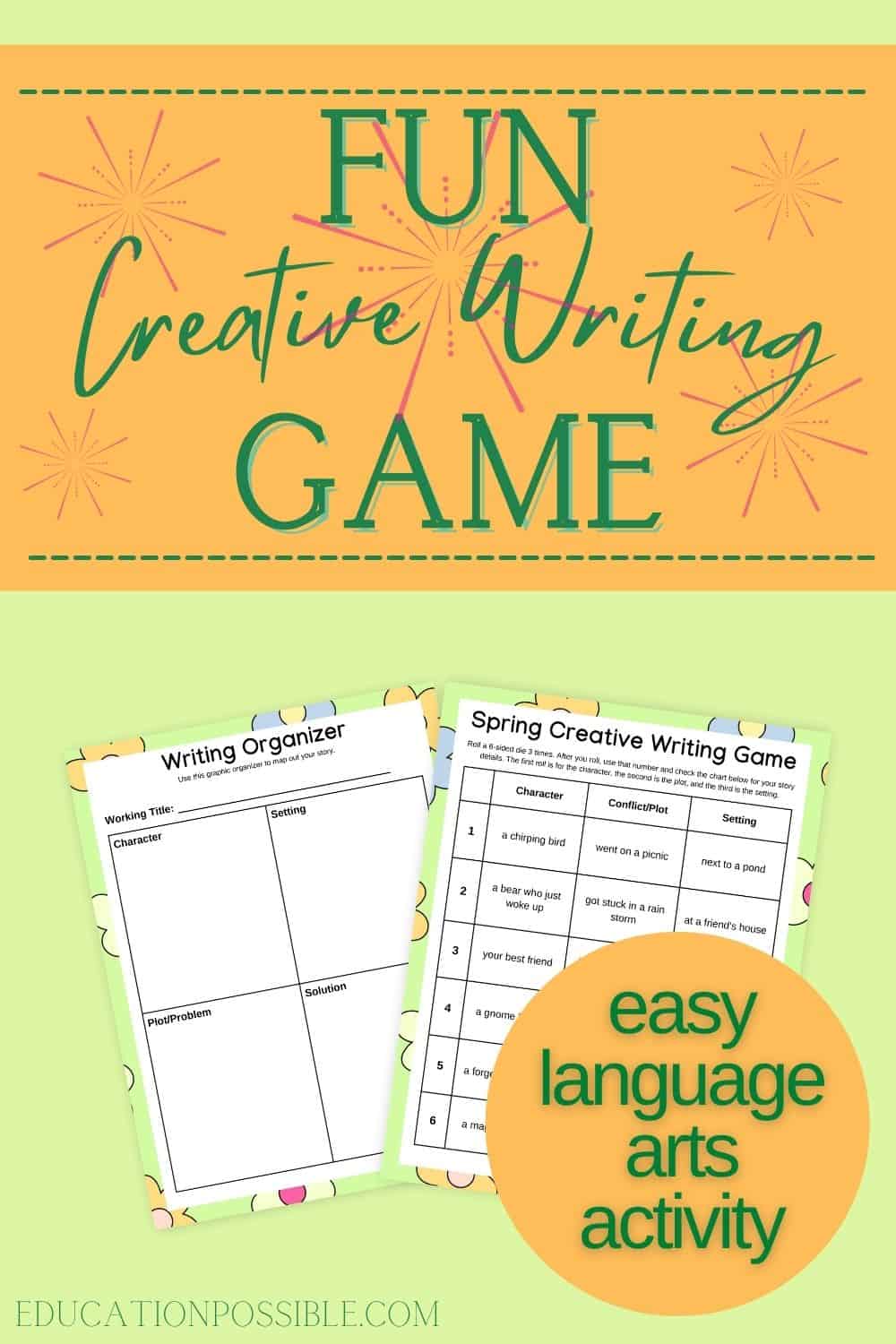Get Tweens Writing With This Spring Creative Writing Game
This spring creative writing game is a great way to inject some fun into your language arts lessons.
Set aside your formal writing for a day and instead have your tweens roll and write their way to a unique story. This activity is easy to set up and play, so the entire family can play together or you can just have your middle schooler do it on their own as an independent learning opportunity.

Any links in this post may be affiliate links. See my disclosure statement.
How To Improve Story Writing
The best way for kids to improve their writing is to write. Consistent practice is the key. Unfortunately, for many middle schoolers, this is challenging. Whether they have trouble with the physical act of writing or feel like they never know how to get started, lots of kids resist writing.
So, how can they get better if they don’t enjoy the process of writing?
One way is by making sure you’re giving them all different kinds of writing assignments. Instead of sticking with the standard essay, teach them how to write things like poetry, persuasive arguments, analytical papers, research projects, and creative stories.
You never know what they’ll connect with, so get them writing regularly by exposing them to a variety of styles.
My favorite way to help my kids get better at storytelling is playing games. They are a fun, non-threatening way for kids to develop their creative thinking ability.
Game To Improve Writing Skills
This printable language arts activity will help your tween develop the three main elements of storytelling; character, setting, and plot.
Games like this are a great tool to use with both reluctant and advanced writers. Reluctant writers often find it helpful to have topics assigned for the character, setting, and plot. This gives them a framework, which is less daunting than starting with a blank page.
Advanced writing students also benefit from playing games like this because it gives them practice working with settings, plots, and characters that differ from what they normally choose. In fact, many professional writers use activities like this daily, to as a practice or warm-up, just like professional musicians warm up by playing scales on their instruments.
Resources you will need:
- A printed copy of the Spring Writing Game (one of the game page, and a copy of the other pages for each player).
- One six-sided die.
- A pencil or pen.
How to play the story writing game
- Roll the die to determine the character. Match the number on the die to the character column. For example, if kids roll a 4, the character of their story will be a gnome family.
- Roll the die for the plot. Match the number on the die to the conflict/plot column. For example, if a 6 is rolled, the story will include a bike ride.
- Roll the die for a setting. Match the number on the die to the setting column. For example, if someone rolls a 2, the story will take place at a friend’s house.
- Next, kids should start filling out the writing organizer with the information they just gathered. This is where they’ll draw out the story and write their ideas. This is a brainstorming session, so remind them they shouldn’t be afraid to make mistakes here. They just need to jot down anything they can think of. It’s easy to cross out ideas they don’t like later. Think of this as a rough draft.
- Once they’re happy with the information on the writing organizer and have a clear idea of the story they want to tell, it’s time to write. Use the Write the Story page to draft the story.
- Print off another copy of the Write the Story page and encourage your tweens to come back to the story to make edits and then nicely write out a final draft. There’s also a spot for them to draw a picture to go with the story.
- Hint: When to add the title. Did you know many authors don’t pick a final title until after they write their story? They use something called a ‘working title’ as they write. Then when they finish, they pick a different title. Sometimes you think of a better title as you write your story. Your tweens should consider the title on their graphic organizer as a working title.
- Example: If you roll, 2-1-3, you can write something like this, “A Giant Easter Bunny Loses His Shoes at a Friend’s House”. But after you write the story, maybe you change your title to something more exciting like, “The Case of the Easter Bunny’s Missing Shoes”.
Tips for using the spring creative writing game
Sometimes, even with a fun game giving them the general topic for their story, kids will be stuck. They know the setting, but they can’t figure out how to write about it. The following tips will help everyone get started on their stories without getting stuck.
Setting questions
- What time of day will your story start?
- How much time will your story cover? Minutes? Hours? Days?
- Think about the weather in your setting. If it’s not assigned, decide what kind of day it is.
- Use adjectives when you describe your setting. (‘dark and stormy night’ is more interesting than ‘one night’.)
Character questions
- Will there be any additional characters in your story?
- What is the personality of your main character?
- Does your main character have a character flaw? (Maybe they are not observant, don’t pay attention, are impatient or angry?)
- In many stories, the main character has to overcome their flaw, or get help, to solve their problem. (Their problem is the plot.)
Plot tips
- Can you throw a wrench in your plot? This means that it will look like your character is easily going to solve their problem, but then something goes wrong, and it seems like they will never be able to fix the problem.
- Try to make your character solve the problem. Stories where a random event fixes things are not as interesting to read because the main character did not actually resolve the problem.
- This doesn’t mean your character can’t need help, or go on a journey searching for help. It just means that they have to use their own strength, brains, or charm to solve the problem instead of random, unexplainable events.
Hopefully, your tweens are excited about telling a springtime story and this creative writing game will help them put it together quickly and easily.
Don’t forget to grab the Springtime writing game for tweens.

Resources
Use these unique tools as part of your language arts lessons.
- Dixit is a fun, creative writing game for tweens and families.
- Help kids move past writer’s block with these interesting writing prompts.
- The Storymatic Kids Cards are a fun way to help writers with stories, characters, scenes, situations, and plots.
DixitCliffhanger Writing PromptsThe Storymatic Kids
Other Creative Writing Activities for Middle School
Here are additional ideas you can use to improve your tween’s writing.
- Get your kids writing more by having them write product reviews.
- Does your child hate writing because they have dysgraphia? Here are some ideas that might help.
- Story Cubes are an easy way to build your tween’s creative thinking skills.





